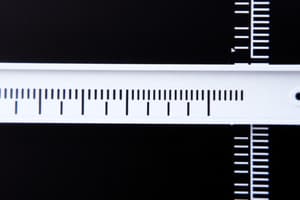Podcast
Questions and Answers
What is the heat required to change a solid to its liquid state known as?
What is the heat required to change a solid to its liquid state known as?
- Heat of fusion (correct)
- Heat of sublimation
- Heat of vaporization
- Heat of condensation
In which process do water molecules move at a slower pace and become more compact?
In which process do water molecules move at a slower pace and become more compact?
- Solidification (correct)
- Sublimation
- Fusion
- Evaporation
What is the boiling point of water in Kelvin scale?
What is the boiling point of water in Kelvin scale?
- 373 K (correct)
- 459.67 K
- 212 K
- 100 K
Which formula represents the relationship between Fahrenheit and Kelvin temperatures?
Which formula represents the relationship between Fahrenheit and Kelvin temperatures?
What is the process of transforming a substance from the solid phase directly to the gas state without passing the liquid phase called?
What is the process of transforming a substance from the solid phase directly to the gas state without passing the liquid phase called?
When a substance changes phase, what changes without changing the temperature?
When a substance changes phase, what changes without changing the temperature?
How can you safely separate drinking glasses stuck to each other?
How can you safely separate drinking glasses stuck to each other?
What happens to the molecules of fluids when they are heated?
What happens to the molecules of fluids when they are heated?
What causes the expansion or contraction of materials when the temperature changes?
What causes the expansion or contraction of materials when the temperature changes?
Why does mercury rise in a glass thermometer as the temperature increases?
Why does mercury rise in a glass thermometer as the temperature increases?
Define heat of fusion.
Define heat of fusion.
What is the freezing point of water in Fahrenheit scale?
What is the freezing point of water in Fahrenheit scale?
Explain the process of solidification.
Explain the process of solidification.
Explain the difference between sublimation and deposition in terms of phase changes.
Explain the difference between sublimation and deposition in terms of phase changes.
How does the process of thermal expansion differ in solids, liquids, and gases?
How does the process of thermal expansion differ in solids, liquids, and gases?
What is the formula that represents the relationship between Fahrenheit and Kelvin temperatures?
What is the formula that represents the relationship between Fahrenheit and Kelvin temperatures?
Explain why pouring hot water over a metal lid cover of a bottle helps in opening it.
Explain why pouring hot water over a metal lid cover of a bottle helps in opening it.
Explain how thermal expansion affects the operation of glass thermometers.
Explain how thermal expansion affects the operation of glass thermometers.
Describe the relationship between temperature change and the expansion or contraction of materials.
Describe the relationship between temperature change and the expansion or contraction of materials.
How does the process of condensation relate to the formation of clouds in the water cycle?
How does the process of condensation relate to the formation of clouds in the water cycle?
Flashcards are hidden until you start studying
Study Notes
Phase Changes
- The heat required to change a solid to its liquid state is known as the heat of fusion.
- During melting, water molecules move at a slower pace and become more compact.
- The boiling point of water is 373.15 K in the Kelvin scale.
Temperature Scales
- The formula representing the relationship between Fahrenheit (F) and Kelvin (K) temperatures is: K = (F - 32) × 5/9 + 273.15.
Phase Transformations
- The process of transforming a substance from the solid phase directly to the gas state without passing the liquid phase is called sublimation.
- When a substance changes phase, its internal energy changes without changing the temperature.
Thermal Expansion
- When a substance is heated, its molecules gain kinetic energy and start moving faster, resulting in expansion.
- Thermal expansion causes materials to expand or contract when the temperature changes.
- Mercury rises in a glass thermometer as the temperature increases due to thermal expansion.
Thermal Expansion and Materials
- Thermal expansion differs in solids, liquids, and gases due to differences in molecular arrangements and freedom of movement.
- In solids, thermal expansion occurs due to increased vibrations of molecules.
- In liquids, molecules slide past each other, allowing for expansion.
- In gases, molecules move freely, leading to rapid expansion.
Practical Applications
- Pouring hot water over a metal lid cover of a bottle helps in opening it by exploiting thermal expansion.
- Thermal expansion affects the operation of glass thermometers, as the liquid inside expands with temperature increases.
Phase Changes and the Water Cycle
- Condensation, the process of gas changing to liquid, relates to the formation of clouds in the water cycle.
- Solidification is the process of a substance changing from the liquid phase to the solid phase.
- Deposition is the process of a gas changing directly to a solid, whereas sublimation is the reverse process.
Studying That Suits You
Use AI to generate personalized quizzes and flashcards to suit your learning preferences.



